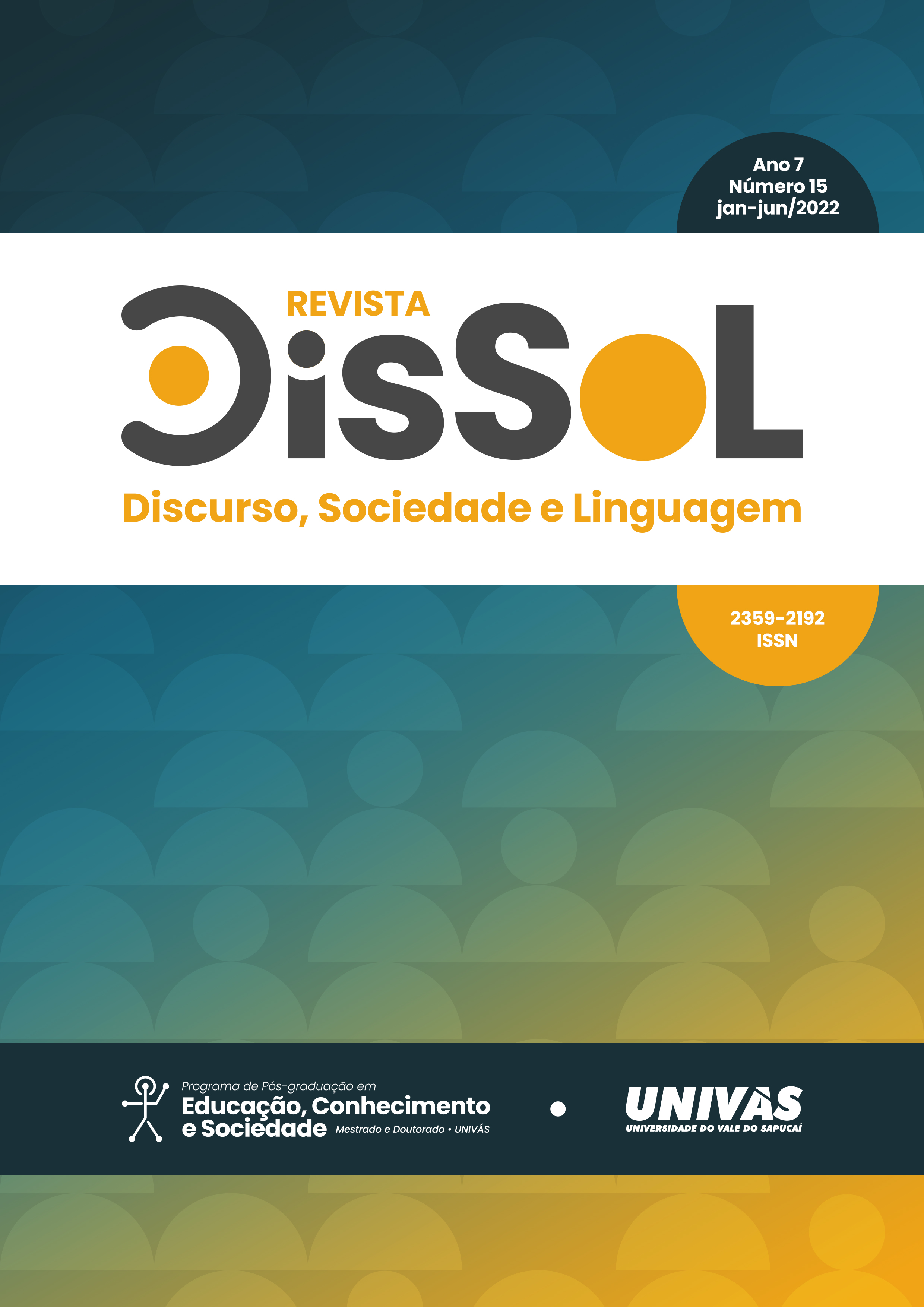A CIÊNCIA MÉDICA E O UNIVERSO SEMÂNTICO DOS APLICATIVOS MÓVEIS: COMO OS JOGOS ELETRÔNICOS SIGNIFICAM O MÉDICO - UMA ANÁLISE DISCURSIVA DO APLICATIVO “TOUCH SURGERY” E “QUIZ DE MEDICINA”
Keywords:
jogos eletrônicos; discurso; Touch Surgery; Quiz de Medicina; médicos
Abstract
Advances in technology applied to health transform medical practice and the training of new professionals in the area. Here we highlight the games developed for mobile devices, used by these professionals. “Touch Surgery” and “Medicine Quiz” are the games that make up the corpus of the research reported here, which are, in this scope, taken as discourse. We analyzed how these games signify to the player part of the semantic universe of medicine, trying to understand how they attribute meaning to the medical professional, to medical knowledge and to medical practice. We mobilized the theory of Discourse Analysis, from which we established a device for reading the historical, social and ideological process that determines the production of these evidence of meaning, anchored in (ir)regularities in the functioning of language that the aforementioned application conforms. Through clippings of game phases, we understand the relationships of meaning that (de)stabilize certain images of how a doctor – his knowledge and practice – can or should be socially conceived. The analyzes point to the production of an effect of robotization of medical practice (the evidence that the practice and/or the surgical procedure are performed mechanically and methodically, through a pre-defined step-by-step and, therefore, and may constitute an object of training for any health professional). We show how this, and other effects are produced by the discursive functioning that the “Touch Surgery” and the “Quiz de Medicina” reproduce.References
BACELAR, Simônides et al. Questões de linguagem médica. Rev. Col. Bras. Cir., Rio de Janeiro , v. 36, n. 1, p. 96-98, Feb. 2009 . Available from . access on 19 Apr. 2021.
DIAS, Cristiane. Análise do discurso digital: Sujeito, Espaço, Memória e Arquivo. Campinas: Pontes, 2018.
Goldenberg S. Publicação do trabalho científico: compromisso ético. São Paulo; 2007. Disponível em: http://www.metodologia.org/saul_etica
Lopes, Mário. Fundamentos de Clínica Médica – A relação Paciente X Médico. Campinas: Medsi Editora Médica e Científica Ltda. 1997.
MAIA, Daniel Eichemberg Fernandes e; RIBEIRO JR., Marcelo Augusto Fontenelle. Manual de condutas básicas de cirurgia. São Paulo: Roca- Brasil, 2013.
Marques, Ruy G. Técnica operatória e cirurgia experimental. São Paulo: Ed. Atheneu, 2005.
Nogueira, Luciana. Discurso, sujeito e relações de trabalho : a posição discursiva da Petrobras. Campinas, SP : [s.n.], 2015.
ORLANDI, Eni. Análise de discurso: princípios e procedimentos. Campinas: Pontes, 2005.
ORLANDI, Eni. Discurso e texto. Campinas: Pontes, 2001.
ORLANDI, E.P. Exterioridade e Ideologia. Campinas: Cad. Est. Ling.,1996.
ORLANDI, E.P. A leitura e os leitores. Campinas: Pontes, 2003.
PÊCHEUX, M. Metáfora e interdiscurso. Campinas: Pontes, 2011. p. 151-161.
Rita, F. G.; Branco, Rodrigues. A relação com o paciente. São Paulo: Guanabara Koogan, 2003.
Smael, J. C. O médico e o paciente. Belo Horizonte: MG Editores, 2005.
SUGAND, K.; MAWKIN, M; GUPTE, C. Validating Touch SurgeryTM: a cognitive task simulation and rehearsal app for intramedullary femoral nailing. Injury, 46(11): 2212–16, 2015.
DIAS, Cristiane. Análise do discurso digital: Sujeito, Espaço, Memória e Arquivo. Campinas: Pontes, 2018.
Goldenberg S. Publicação do trabalho científico: compromisso ético. São Paulo; 2007. Disponível em: http://www.metodologia.org/saul_etica
Lopes, Mário. Fundamentos de Clínica Médica – A relação Paciente X Médico. Campinas: Medsi Editora Médica e Científica Ltda. 1997.
MAIA, Daniel Eichemberg Fernandes e; RIBEIRO JR., Marcelo Augusto Fontenelle. Manual de condutas básicas de cirurgia. São Paulo: Roca- Brasil, 2013.
Marques, Ruy G. Técnica operatória e cirurgia experimental. São Paulo: Ed. Atheneu, 2005.
Nogueira, Luciana. Discurso, sujeito e relações de trabalho : a posição discursiva da Petrobras. Campinas, SP : [s.n.], 2015.
ORLANDI, Eni. Análise de discurso: princípios e procedimentos. Campinas: Pontes, 2005.
ORLANDI, Eni. Discurso e texto. Campinas: Pontes, 2001.
ORLANDI, E.P. Exterioridade e Ideologia. Campinas: Cad. Est. Ling.,1996.
ORLANDI, E.P. A leitura e os leitores. Campinas: Pontes, 2003.
PÊCHEUX, M. Metáfora e interdiscurso. Campinas: Pontes, 2011. p. 151-161.
Rita, F. G.; Branco, Rodrigues. A relação com o paciente. São Paulo: Guanabara Koogan, 2003.
Smael, J. C. O médico e o paciente. Belo Horizonte: MG Editores, 2005.
SUGAND, K.; MAWKIN, M; GUPTE, C. Validating Touch SurgeryTM: a cognitive task simulation and rehearsal app for intramedullary femoral nailing. Injury, 46(11): 2212–16, 2015.
Published
2022-12-06
How to Cite
Faria, J., & Souza Gonçalves, M. de L. (2022). A CIÊNCIA MÉDICA E O UNIVERSO SEMÂNTICO DOS APLICATIVOS MÓVEIS: COMO OS JOGOS ELETRÔNICOS SIGNIFICAM O MÉDICO - UMA ANÁLISE DISCURSIVA DO APLICATIVO “TOUCH SURGERY” E “QUIZ DE MEDICINA” . Revista DisSoL - Discurso, Sociedade E Linguagem, (15). https://doi.org/10.35501/dissol.vi15.1059
Section
Artigos
Autores que publicam na Revista DisSoL mantêm os direitos autorais e concedem à revista o direito de primeira publicação, com o trabalho simultaneamente licenciado sob a Licença Creative Commons Attribution que permite o compartilhamento do trabalho com reconhecimento da autoria e publicação inicial nesta revista.
Ao submeterem textos para avaliação e possível publicação nesta revista os autores comprometem-se a respeitar os preceitos éticos de produção e publicação de pesquisas científicas.





